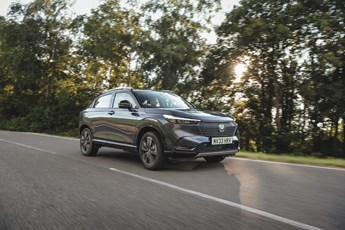
The start point for the best source of fleet information |
First drive: Honda HR-V
Date: 12 November 2021 | Author: Pete Tullin

|
|
||||||||||||||||
Given the Honda CR-V is one of the world's best-selling SUVs it's difficult to understand why its smaller HR-V brethren hardly gets a look in. Honda reckons this is partially due to an identity crisis, so it is keen to push the message that its latest HR-V is a direct rival to the Toyota CH-R.
The trouble with this association is, compared with the Toyota's Paris-Dakar racer contours and wildly aggressive road stance, the HR-V's sensible shoes approach makes it seem more suited to a racy game of dominoes.
It's far from ugly, but it does have the look of a car designed by a risk-averse committee and those large gaps between the tops of the tyres and the wheel arches give you some indication as to how it drives.
The suspension most definitely prioritises comfort over control and at low speeds that's fine, providing you're happy with the lolling levels of body freedom and the associated lateral shimmying that this approach dictates.
Some may even argue this is exactly what is required, given the poor state of our urban road surfaces and given the HR-V also deals with harsh low-speed impacts in an acoustically
refined manner.
Once speeds increase, however, things quickly begin to deteriorate.
Although the steering is well weighted and the brakes are reassuringly strong, this good work is ultimately undermined by high levels of body lean in corners, a tendency to take a gentle bit of lane meandering when hit by motorway side winds and even some throwback 80's style inside wheel pick up and tyre spin when pulling briskly out of a T-junctions. Consequently, it doesn't take long before concluding Honda may have let things slide a wee bit too far down the freedom front.
It's a similar story when it comes to motivation. Although Honda can produce countless pie charts proving just how and why its 1.5-litre petrol engine and twin electric motor hybrid is superior to an equivalent Toyota set up, and the clever decoupling of various power-sapping components offer great efficiency gains, not everything is sweetness and light.
At lower speeds, the synergising of electric and petrol hybrid power outputs is impressively seamless but stand on the accelerator with any kind of intent and the noise levels produced by the petrol engine, given unbridled freedom to hit the upper echelons of the rev range by the slippery CVT transmissions, intensify the decibel levels quite dramatically.
Fortunately, once up to cruising speeds and things settle into an uneasy truce, which will give you the opportunity to admire the surroundings.
While the dashboard is neatly laid out, and praise be Honda for maintaining dials and switches for the climate controls rather than following the current trend to integrate them into the touchscreen, the materials used throughout are also of excellent quality and tastefully styled.
All-round visibility is excellent too, especially the front three-quarters view, thanks to the slim A-pillars and door-mounted mirrors, along with some large side windows. While storage for odds and sods is pretty decent, the HR-V comes with Honda's party-piece 'magic rear seats,' which can be folded in myriad different configurations to free up various load options.
Things aren't quite as impressive for rear occupants, however. With a very narrow centre rear pew, it's probably best to think of the HR-V as a four rather than a five-seater and because the fuel tank is located in the middle of the vehicle, this creates a ramp under the front seats - which is not ideal for rear passengers with excessively sized plates of meat.
Overall then, although the HR-V has some likeable elements but it also has plenty of flaws and we can only imagine these weaknesses will be exposed by superior rivals in what is a hugely competitive sector.
Honda HR-V e:Hev Advance Style
P11D: £31,435
Residual value: 40.55%
Depreciation: £18,689
Fuel: £7,061
Service, maintenance and repair: £1,840
Cost per mile: 45.98p
Fuel consumption: 52.3mpg
CO2 (BIK %): 122g/km (28%)
Luggage capacity: 335 litres
Engine size/power: 1498cc/107hp, plus 131hp twin electric motors
Verdict |
6/10 |
|||
 |
|
 |
|
|










